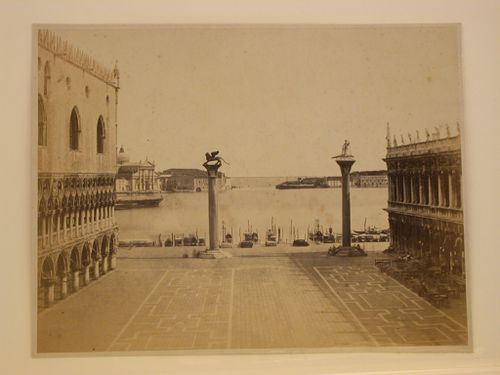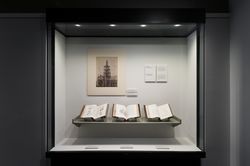textual records, photographs
Quantity:
41 file
Architects and Buildings
ARCH242861
Description:
Architects and Buildings: Tadao Ando Coop Himmelblau Le Corbusier Decoi (Architects) Goulthorpe Peter Eisenman R. Buckminster Fuller Garofalo Architects Michael Graves - Dismey Frank Gehry - various projects Zaha Hadid Wallace K. Harrison John Hejduk Herzog and de Meuron Chuck Hoberman Arata Isozaki Toyo Ito Philip Johnson Louis Kahn Kennedy & Violich Rem Koolhaas Daniel Libeskind Adolf Loos Machado & Silvetti Architects Michelangelo (Laurentian Library) Rafael Moneo Palladio John Pawson I.M. Pei - Louvre Pyramid Portzamparc Rockwell Group Architects Colin Rowe Shoei Yoh & Architects Solà-Morales Robert A.M. Stern James Stirling G. Terragni Tishman Realty & Construction Bernard Tschumi Mies van der Rohe Venturi, Scott Brown & Associates Frank Lloyd Wright
Architects and Buildings
Actions:
ARCH242861
Description:
Architects and Buildings: Tadao Ando Coop Himmelblau Le Corbusier Decoi (Architects) Goulthorpe Peter Eisenman R. Buckminster Fuller Garofalo Architects Michael Graves - Dismey Frank Gehry - various projects Zaha Hadid Wallace K. Harrison John Hejduk Herzog and de Meuron Chuck Hoberman Arata Isozaki Toyo Ito Philip Johnson Louis Kahn Kennedy & Violich Rem Koolhaas Daniel Libeskind Adolf Loos Machado & Silvetti Architects Michelangelo (Laurentian Library) Rafael Moneo Palladio John Pawson I.M. Pei - Louvre Pyramid Portzamparc Rockwell Group Architects Colin Rowe Shoei Yoh & Architects Solà-Morales Robert A.M. Stern James Stirling G. Terragni Tishman Realty & Construction Bernard Tschumi Mies van der Rohe Venturi, Scott Brown & Associates Frank Lloyd Wright
textual records, photographs
Quantity:
41 file
PH1981:1161
architecture, sculpture
between 1850 and 1879
architecture, sculpture
archives
Level of archival description:
Fonds
Lionel March fonds
AP208
Synopsis:
The Lionel March fonds, circa 1957-2017, documents the work and activities of architect and professor Lionel March. The records within this fonds illustrate March’s architectural career, representing five professional and personal building projects, including the 1964 Whitehall plan; as well as his academic career in research and teaching, spanning England and North America, most notably March’s work with the Centre for Land Use and Built Form Studies (now the Martin Centre) and his research at UCLA. The fonds is largely composed of books from March’s library, textual records, slides and photographs, and drawings.
circa 1957-2017
Lionel March fonds
Actions:
AP208
Synopsis:
The Lionel March fonds, circa 1957-2017, documents the work and activities of architect and professor Lionel March. The records within this fonds illustrate March’s architectural career, representing five professional and personal building projects, including the 1964 Whitehall plan; as well as his academic career in research and teaching, spanning England and North America, most notably March’s work with the Centre for Land Use and Built Form Studies (now the Martin Centre) and his research at UCLA. The fonds is largely composed of books from March’s library, textual records, slides and photographs, and drawings.
archives
Level of archival description:
Fonds
circa 1957-2017
The Anatomy of the Architectural Book, an exhibition presented in conjunction with the publication of a book of the same title by André Tavares, examines the relationships between book culture and building culture, making visible the axes along which architectural knowledge circulates through books into buildings and back. Through seven themes—Texture, Spread, Sequence,(...)
10 May 2016 to 20 November 2016
The Anatomy of the Architectural Book
Actions:
Description:
The Anatomy of the Architectural Book, an exhibition presented in conjunction with the publication of a book of the same title by André Tavares, examines the relationships between book culture and building culture, making visible the axes along which architectural knowledge circulates through books into buildings and back. Through seven themes—Texture, Spread, Sequence,(...)
archives
Level of archival description:
Collection
CD033
Synopsis:
The Aldo Cibic Microrealities project collection primarily consists of presentation materials, publications and born digital materials, like videos and photographs, by Aldo Cibic produced between 2003 and 2008 for the project “Microrealities”.
2003-2008
Aldo Cibic Microrealities project collection
Actions:
CD033
Synopsis:
The Aldo Cibic Microrealities project collection primarily consists of presentation materials, publications and born digital materials, like videos and photographs, by Aldo Cibic produced between 2003 and 2008 for the project “Microrealities”.
archives
Level of archival description:
collection
2003-2008
photographs
AP207.S4.018
Description:
Includes reference slides on Alessandro Mendini's works, on seaside clubs and colonies, Andrea Palladio's works, and landscape architecture.
1970s-1990s
References slides used as teaching material
Actions:
AP207.S4.018
Description:
Includes reference slides on Alessandro Mendini's works, on seaside clubs and colonies, Andrea Palladio's works, and landscape architecture.
photographs
1970s-1990s
Sub-series
Domestic Commissions
CI001.S1.D2
Description:
Hubert and Charles Rohault de Fleury received domestic commissions for both urban housing -hôtel particuliers and apartment houses- and rural dwellings -châteaux, country houses and estates. Hubert also executed designs for furniture and garden pavilions. Hubert' work is characterized by restrained classical exteriors and luxurious Empire style interiors; both Charles' exteriors and interiors, especially those for Hôtels Sauvage and Soltykoff, reflect the exuberance of the Second Empire. The CCA albums include drawings from all stages of the design process but with an emphasis on design development drawings. Hubert's albums contain cost calculations and estimates, notes and letters. In general, the drawings by Charles are from a more developed phase of design than Hubert's; Hubert's commissions are more varied than Charles'. The austere classicism of Hubert's domestic work reflects the prevailing taste of the day and reveals the strong influence of his teacher, Jean Nicholas Louis Durand. The compostional effect of the houses' façades relies on the shape and rhythm of the fenestration and the geometric division by string courses and occasionally, pilasters. Columns are used infrequently as is decorative stonework. The plans are symmetrical and modular. This approach to design is especially evident in the series of proposals for a country house for comte Treilhard (DR1974:0002:034:001-082) and in a group of unidentified designs for houses (DR1974:0002:035:001-034), all of which illustrate an emphasis on plan in the design process and a distinct approach to the composition of the elevations, both derived from Durand. Hubert's domestic work was also influenced by Palladio (see especially DR1974:0002:038:001-029). The interiors and furniture designed by Hubert are typical of the Empire style (1). The drawings in the CCA collection illustrate the materials, palette and ornamental motifs of the period. The garden structures in Hubert's albums are more fanciful than his houses and are either Rustic, Chinoiserie or classical in style (2). His garden designs follow the contemporary French trend for "jardins anglais" with winding paths and naturalistic placement of the vegetation, sometimes in combination with more formal French gardens (3). One of the most comprehensively documented domestic project by Hubert is the Rohault de Fleury House (12-14 rue d'Aguesseau; 1824). The CCA collection contains an interesting series of preliminary drawings for alternate proposals for this house, a number of highly finished wash drawings (including the interior decorative scheme) for the final scheme (DR1974:0002:011:001-08) and several earlier (ca. 1806) proposals (DR1974:0002:035:001-034). The Domaine de la Vallée album (DR1974:0002:025:001-059) is notable for the range of subject matter included as well as for the insights into the character of a working country estate in the nineteenth century. The proposed modifications encompassed both functional (a bridge, a levee, granaries and stables) and aesthetic improvements, such as ornamental garden temples. The renovation of the house also exhibits both functional and aesthetic improvements. (1) Examples of Hubert's interiors and furniture can be found in albums, DR1974:0002:007:001-068, DR1974:0002:011:001-089, DR1974:0002:025:001-059, DR1974:0002:030:001-065 and DR1974:0002:035:001-034. (2) The best examples of his pavilions are found in album, DR1974:0002:038:001-029 with other examples in albums, DR1974:0002:025:001-059, DR1974:0002:030:001-065 and DR1974:0002:035:001-034. (3) Examples are found in albums, DR1974:0002:035:001-034 and DR1974:0002 :025:001-059. Also of note are drawings, DR1974:0002:007:007 and DR1974:0002:007:068.
1802-[1840]
Domestic Commissions
CI001.S1.D2
Description:
Hubert and Charles Rohault de Fleury received domestic commissions for both urban housing -hôtel particuliers and apartment houses- and rural dwellings -châteaux, country houses and estates. Hubert also executed designs for furniture and garden pavilions. Hubert' work is characterized by restrained classical exteriors and luxurious Empire style interiors; both Charles' exteriors and interiors, especially those for Hôtels Sauvage and Soltykoff, reflect the exuberance of the Second Empire. The CCA albums include drawings from all stages of the design process but with an emphasis on design development drawings. Hubert's albums contain cost calculations and estimates, notes and letters. In general, the drawings by Charles are from a more developed phase of design than Hubert's; Hubert's commissions are more varied than Charles'. The austere classicism of Hubert's domestic work reflects the prevailing taste of the day and reveals the strong influence of his teacher, Jean Nicholas Louis Durand. The compostional effect of the houses' façades relies on the shape and rhythm of the fenestration and the geometric division by string courses and occasionally, pilasters. Columns are used infrequently as is decorative stonework. The plans are symmetrical and modular. This approach to design is especially evident in the series of proposals for a country house for comte Treilhard (DR1974:0002:034:001-082) and in a group of unidentified designs for houses (DR1974:0002:035:001-034), all of which illustrate an emphasis on plan in the design process and a distinct approach to the composition of the elevations, both derived from Durand. Hubert's domestic work was also influenced by Palladio (see especially DR1974:0002:038:001-029). The interiors and furniture designed by Hubert are typical of the Empire style (1). The drawings in the CCA collection illustrate the materials, palette and ornamental motifs of the period. The garden structures in Hubert's albums are more fanciful than his houses and are either Rustic, Chinoiserie or classical in style (2). His garden designs follow the contemporary French trend for "jardins anglais" with winding paths and naturalistic placement of the vegetation, sometimes in combination with more formal French gardens (3). One of the most comprehensively documented domestic project by Hubert is the Rohault de Fleury House (12-14 rue d'Aguesseau; 1824). The CCA collection contains an interesting series of preliminary drawings for alternate proposals for this house, a number of highly finished wash drawings (including the interior decorative scheme) for the final scheme (DR1974:0002:011:001-08) and several earlier (ca. 1806) proposals (DR1974:0002:035:001-034). The Domaine de la Vallée album (DR1974:0002:025:001-059) is notable for the range of subject matter included as well as for the insights into the character of a working country estate in the nineteenth century. The proposed modifications encompassed both functional (a bridge, a levee, granaries and stables) and aesthetic improvements, such as ornamental garden temples. The renovation of the house also exhibits both functional and aesthetic improvements. (1) Examples of Hubert's interiors and furniture can be found in albums, DR1974:0002:007:001-068, DR1974:0002:011:001-089, DR1974:0002:025:001-059, DR1974:0002:030:001-065 and DR1974:0002:035:001-034. (2) The best examples of his pavilions are found in album, DR1974:0002:038:001-029 with other examples in albums, DR1974:0002:025:001-059, DR1974:0002:030:001-065 and DR1974:0002:035:001-034. (3) Examples are found in albums, DR1974:0002:035:001-034 and DR1974:0002 :025:001-059. Also of note are drawings, DR1974:0002:007:007 and DR1974:0002:007:068.
File 2
1802-[1840]
books
Description:
569 pages : illustrations ; 29 cm
Milano : Electa, ©1999.
Andrea Palladio / Lionello Puppi.
Actions:
Holdings:
Description:
569 pages : illustrations ; 29 cm
books
Milano : Electa, ©1999.
books
Description:
1 volume (unpaged) : chiefly color illustrations, plans ; 43 cm
Udine, Italy : Magnus Edizioni, ©2011.
Andrea Palladio / [Christoph Ulmer].
Actions:
Holdings:
Description:
1 volume (unpaged) : chiefly color illustrations, plans ; 43 cm
books
Udine, Italy : Magnus Edizioni, ©2011.
journals and magazines
Palladio.
Description:
volumes illustrations 29 cm
Roma, De Luca Editore
journals and magazines
Roma, De Luca Editore

